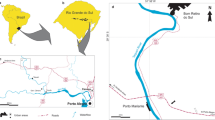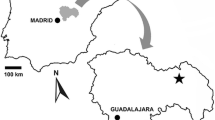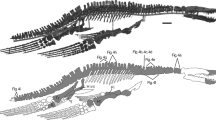Abstract
Rhynchosaurs first appear in the Early Triassic fossil record and flourished during the late Carnian as the dominant members of several assemblages worldwide. In Argentina, the rhynchosaur record is currently restricted to the Ischigualasto Formation of late Carnian–earliest Norian age. Recent fieldwork in the new locality of Brazo del Puma, in the lowermost levels of the Chañares Formation, yielded three rhynchosaur tooth-bearing bones, which were collected five metres above the contact with the underlying Tarjados Formation. The most complete specimen is the posterior end of the alveolar region of a left dentary. The dentary possesses densely packed tooth rows on the lingual surface and medial half of the occlusal surface, showing longitudinal Zahnreihen. The teeth of the occlusal surface are worn flat and those of the lingual surface are organized in multiple rows, supporting the referral of the specimen to Rhynchosauridae. In addition, the dentary teeth are conical to mesiodistally compressed, resembling the condition observed in hyperodapedontines. The rhynchosaur remains reported here are the oldest collected in Argentina and among the oldest in South America, together with an unnamed form from Brazil. The new rhynchosaur specimens come from levels in which dicynodonts are numerically dominant, whereas cynodonts are considerably less abundant. Accordingly, the specimens reported here bolster faunal differences within the Chañares Formation and add a new faunal component to this already diverse vertebrate assemblage.
Kurzfassung
Rhynchosaurier sind erstmals für die Untere Trias im Fossilbericht nachgewiesen und erlebten ihre Blüte im Oberen Karnium, als eine dominierende Gruppe in merheren Fossilgesellschaften weltweit. In Argentinien sind Rhynchosauier bislang nur für die Ischigualasto Formation (Oberes Karnium-Unteres Norium) belegt. Kürzliche Grabungen in einer neuen Lokalität in Brazo del Puma, im unteresten Niveau der Chañares Formation, ergaben drei zahntragende Knochen von Rhynchosaurierern. Die Knochen wurden ungefähr fünf Meter über unterliegenden Tarjados Formation gefunden. Der vollständigste Knochen repräsentiert das posteriore Ende der Zahnregion in der linken Dentale. Die Dentale besitzt dichtgepackte Zahnreihen auf der lingualen Seite und längslaufenden Zahnreihen auf der medialen Hälfte der okklusalen Seite. Die abgeflachten Zähne der okklusalen Seite sowie die mehrreihige Anordnung der Zähne auf der lingualen Seite erlaubt eine Zuordnung zu den Rhynchosauriden. Die Zähne der Dentalen sind zusätzlich konisch bis mesiodistad zusammengedrückt, ähnlich den Zähnen von Hyperodapedontinen. Zusammen mit unbeschriebenen Resten aus Brasilien, repräsentieren die hier vorgestellten Reste den ältesten Nachweis von Rhynchosauriern aus Argentinien beziehungsweise Südamerika. Die Rhynchosaurierknochen stammen aus einem Niveau, dass vor allem durch Dicynodonten dominiert ist, während Cynodonten seltener vorkommen. Die hier vorgelstellten Reste erweitern daher die bekannte Fauna der Chañares Formation um eine weitere Gruppe und belegen zusätzlich zeitliche Unterschiede in der Faunenzusammensetzung innerhalb der Formation.


Similar content being viewed by others
Abbreviations
- CRILAR-Pv:
-
Centro Regional de Investigaciones y Transferencia Tecnológica de La Rioja, Paleontología de Vertebrados, Anillaco, La Rioja, Argentina
References
Baczko, von, M.B., and Ezcurra, M.D. 2013. Ornithosuchidae: a group of Triassic archosaurs with a unique ankle joint. In Anatomy, Phylogeny and Palaeobiology of Early Archosaurs and their Kin, eds. Nesbitt, S.J., Desojo, J.B., and Irmis, R.B., 187–202. London: Geological Society, Special Publications 379. doi:10.1144/SP379.4.
Benton, M.J. 1983a. The Triassic reptile Hyperodapedon from Elgin: functional morphology and relationships. Philosophical Transactions of the Royal Society of London. Series B 302: 605–717.
Benton, M.J. 1983b. Dinosaur success in the Triassic: a noncompetitive ecological model. The Quarterly Review of Biology 58: 29–55.
Benton, M.J. 1984. Tooth form, growth, and function in Triassic rhynchosaurs (Reptilia, Diapsida). Palaeontology 27: 737–776.
Benton, M.J. 1990. The species of Rhynchosaurus, a rhynchosaur (Reptilia, Diapsida) from the Middle Triassic of England. Philosophical Transactions of the Royal Society of London. Series B 328: 213–306.
Butler, R.J., S.L. Brusatte, M. Reich, S.J. Nesbitt, R.R. Schoch, and J.J. Hornung. 2011. The sail-backed reptile Ctenosauriscus from the latest Early Triassic of Germany and the timing and biogeography of the early archosaur radiation. PLoS ONE 6: e25693. doi:10.1371/journal.pone.0025693.
Carroll, R.L. 1976. Noteosuchus—the oldest known rhynchosaur. Annals of the South African Museum 72: 37–57.
Chatterjee, S. 1974. A rhynchosaur from the Upper Triassic Maleri Formation of India. Philosophical Transactions of the Royal Society of London. Series B 267: 209–261.
Chatterjee, S. 1980. The evolution of rhynchosaurs. Mémoires de la Société Géologique de France. Nouvelle Série 139: 57–65.
DeMar, R. 1971. Evolutionary implications of Zahnreihen. Evolution 26: 435–450.
Desojo, J.B., M.D. Ezcurra, and C.L. Schultz. 2011. An unusual new archosauriform from the Middle-Late Triassic of southern Brazil and the monophyly of Doswelliidae. Zoological Journal of the Linnean Society 161: 839–871.
Desojo, J.B., Heckert, A.B., Martz, J.W., Parker, W.G., Schoch, R.R., Small, B.J., and Sulej, T. 2013. Aetosauria: a clade of armoured pseudosuchians from the Late Triassic continental beds. In Anatomy, Phylogeny and Palaeobiology of Early Archosaurs and their Kin, eds. Nesbitt, S.J., Desojo, J.B., and Irmis, R.B., 203–239. London: Geological Society, Special Publications 379.
Dilkes, D.W. 1995. The rhynchosaur Howesia browni from the Lower Triassic of South Africa. Palaeontology 38: 665–685.
Dilkes, D.W. 1998. The Early Triassic rhynchosaur Mesosuchus browni and the interrelationships of basal archosauromorph reptiles. Philosophical Transactions of the Royal Society of London. Series B 353: 501–541.
Ezcurra, M.D., Butler, R.J., and Gower, D.J. 2013. ‘Proterosuchia’: the origin and early history of Archosauriformes. In Anatomy, Phylogeny and Palaeobiology of Early Archosaurs and their Kin, eds. Nesbitt, S.J., Desojo, J.B., and Irmis, R.B., 9–33. London: Geological Society, Special Publications 379. doi:10.1144/SP379.11.
Fiorelli, L.E., M.D. Ezcurra, J.R.A. Taborda, M.J. Trotteyn, M.B. Baczko von, M. Iberlucea, and J.B. Desojo. 2011. A new tetrapod-bearing assemblage from the late Middle Triassic Chañares Formation, La Rioja Province, Argentina. Libro de Resúmenes Reunión Anual de la Asociación Paleontológica Argentina 2011: 32–33.
Furin, S., N. Preto, M. Rigo, G. Roghi, P. Gianolla, J.L. Crowley, and S.A. Bowring. 2006. High-precision U-Pb zircon age from the Triassic of Italy: implications for the Triassic time scale and the Carnian origin of calcareous nannoplankton and dinosaurs. Geology 34: 1009–1012.
Haughton, S.H. 1932. On a collection of Karoo vertebrates from Tanganyika territory. Quarterly Journal of the Geological Society of London 88: 643–662.
Hone, D.W.E., and M.J. Benton. 2008. A new genus of rhynchosaur from the Middle Triassic of SW England. Palaeontology 51: 95–115.
Huene, von F. 1938. Stenaulorhynchus, ein Rhynchosauride der ostafrikanischer Obertrias. Nova Acta Leopoldina, Neue Folge 6: 83–121.
Huene, von F. 1946. Die grossen Stämme der Tetrapoden in den geologischen Zeiten. Biologisches Zentralblatt 65: 268–275.
Huxley, T.H. 1859. Postscript to Murchinson, R. I. On the sandstones of Morayshire (Elgin and c.) containing reptilian remains, and their relations to the Old Red Sandstone of that country. Quarterly Journal of the Geological Society of London 15: 138–152.
Langer, M.C. 2005. Studies on continental Late Triassic tetrapod biochronology. II. The Ischigualastian and a Carnian global correlation. Journal of South American Earth Sciences 19: 219–239.
Langer, M.C., and C.L. Schultz. 2000. A new species of the Late Triassic rhynchosaur Hyperodapedon from the Santa Maria Formation of South Brazil. Palaeontology 43: 633–652.
Langer, M.C., M. Boniface, G. Cuny, and L. Barbieri. 2000. The phylogenetic position of Isalorhynchus genovefae, a Late Triassic rhynchosaur from Madagascar. Annales de Paléontologie 86: 101–127.
Langer, M.C., Ribeiro, A.M., Schultz, C.L., and Ferigolo, J. 2007. The continental tetrapod–bearing Triassic of South Brazil. In The Global Triassic, eds. Lucas, S.G., and Spielmann, J.A., 201–218. Albuquerque, New Mexico Museum of Natural History and Science Bulletin 41.
Langer, M.C., M.D. Ezcurra, J. Bittencourt, and F.E. Novas. 2010a. The origin and early radiation of dinosaurs. Biological Reviews 85: 55–110.
Langer, M.C., F.C. Montefeltro, D.W.E. Hone, R. Whatley, and C.L. Schultz. 2010b. On Fodonyx spenceri and a new rhynchosaur from the Middle Triassic of Devon. Journal of Vertebrate Paleontology 30: 1884–1888.
Langer, M.C., Nesbitt, S.J., Bittencourt, J.S., and Irmis, R.B. 2013. Non-dinosaurian Dinosauromorpha. In Anatomy, Phylogeny and Palaeobiology of Early Archosaurs and their Kin, eds. Nesbitt, S.J., Desojo, J.B., and Irmis, R.B., 157–186. London: Geological Society, Special Publications 379. doi:10.1144/SP379.9.
Laurin, M. 1991. The osteology of a Lower Permian eosuchian from Texas and a review of diapsid phylogeny. Zoological Journal of the Linnean Society 101: 59–95.
Montefeltro, F.C., M.C. Langer, and C.L. Schultz. 2010. Cranial anatomy of a new genus of hyperodapedontine rhynchosaur (Diapsida, Archosauromorpha) from the Upper Triassic of Southern Brazil. Earth and Environmental Sciences Transactions of the Royal Society of Edinburgh 101: 27–52.
Montefeltro, F.C., J.S. Bittencourt, M.C. Langer, and C.L. Schultz. 2013. Postcranial anatomy of the hyperodapedontine rhynchosaur Teyumbaita sulcognathus (Azevedo and Schultz, 1987) from the Late Triassic of southern Brazil. Journal of Vertebrate Paleontology 33: 67–84.
Nesbitt, S.J. 2011. The early evolution of archosaurs: relationships and the origin of major clades. Bulletin of the American Museum of Natural History 352: 1–292.
Nesbitt, S., and R. Whatley. 2004. The first discovery of a rhynchosaur from the Upper Moenkopi Formation (Middle Triassic) of northern Arizona. PaleoBios 24: 1–10.
Osborn, H.F. 1903. The reptilian subclasses Diapsida and Synapsida and the early history of the Diaptosauria. Memoirs of the American Museum of Natural History 1: 449–507.
Owen, R. 1842. Description of an extinct lacertian reptile, Rhynchosaurus articeps, Owen, of which the bones and footprints characterize the upper New Red Sandstone at Grinsill, near Shrewsbury. Transactions of the Cambridge Philosophical Society 7: 355–369.
Raath, M.A., P.M. Oesterlen, and J.W. Kitching. 1992. First record of Triassic Rhynchosauria (Reptilia: Diapsida) from the Lower Zambezi Valley, Zimbabwe. Palaeontologia Africana 29: 1–10.
Rogers, R.R., C.C. Swisher III, P.C. Sereno, C.A. Forster, and A.M. Monetta. 1993. The Ischigualasto tetrapod assemblage (Late Triassic) and 40Ar/39Ar calibration of dinosaur origins. Science 260: 794–797.
Rogers, R.R., A.B. Arcucci, F. Abdala, P.C. Sereno, C.A. Forster, and C.L. May. 2001. Paleoenvironment and taphonomy of the Chañares Formation tetrapod assemblage (Middle Triassic), northwestern Argentina: spectacular preservation in volcanogenic concretions. Palaios 16: 461–481.
Romer, A.S. 1966. The Chañares (Argentina) Triassic reptile fauna. I. Introduction. Breviora 247: 1–14.
Romer, A.S. 1970. Middle Triassic tetrapod faunas of South America. Actas del IV Congreso Latinoamericano de Zoología 2: 1101–1118.
Romer, A.S. 1973. The Chañares (Argentina) Triassic reptile fauna. XX. Summary. Breviora 413: 1–20.
Schultz, C.L., and S.A. Azevedo. 1990. Dados preliminares sobre a ocorrência de uma nova forma de rincossauro para o Triássico do Rio Grande do Sul–Brasil. Paula-Coutiana 4: 35–44.
Sill, W.D. 1970. Schaphonyx sanjuanensis, nuevo rincosaurio (Repitilia) de la Formacion Ischigualasto, Triasico de San Juan, Argentina. Ameghiniana 7: 341–354.
Stocker, M.R., and Butler, R.J. 2013. Phytosauria. In Anatomy, Phylogeny and Palaeobiology of Early Archosaurs and their Kin, eds. Nesbitt, S.J., Desojo, J.B., and Irmis, R.B., 91–117. London: Geological Society, Special Publications 379. doi:10.1144/SP379.5.
Trotteyn, M.J., Arcucci, A.B., and Raugust, T. 2013. Proterochampsia: en endemic archosauriform clade from South America. In Anatomy, Phylogeny and Palaeobiology of Early Archosaurs and their Kin, eds. Nesbitt, S.J., Desojo, J.B., and Irmis, R.B., 59–90. London: Geological Society, Special Publications 379.
Watson, D.M.S. 1912. Mesosuchus browni, gen. et spec. nov. Records of the Albany Museum 2: 298–299.
Acknowledgments
We thank the Agencia de Cultura de La Rioja and the Administración de Parques Nacionales of Argentina for granting permits to work in the Talampaya National Park. We are also indebted to the rangers of the Talampaya National Park for their help in the field. We appreciate discussion with José F. Bonaparte about the fossiliferous levels of the Chañares Formation and information on the field trips conducted by him in the 1970s. We thank Richard Butler for his comments on the manuscript and we appreciate the comments of Max Langer, Cesar Schultz and Atila Da-Rosa regarding the identification of the specimens and the reviewers Michael Benton and Max Langer for their comments and suggestions that improved the quality of the manuscript. We thank the following curators and researchers who provided access to specimens under their care for the purpose of this research: Billy de Klerk (AM), Gabriela Sobral and Johannes Müller (MB), Sandra Chapman and Lorna Steel (NHMUK), and Sheena Kaal and Roger Smith (SAM). M.D.E. is supported by a grant of the DFG Emmy Noether Programme to Richard Butler (BU 2587/3-1). Fieldwork and research funded by the Agencia Nacional de Investigaciones Científicas y Técnicas (PICT 2010-0207 to J.B.D.) and Secretaría de Gobierno, La Rioja (to L.E.F.).
Author information
Authors and Affiliations
Corresponding author
Rights and permissions
About this article
Cite this article
Ezcurra, M.D., Trotteyn, M.J., Fiorelli, L.E. et al. The oldest rhynchosaur from Argentina: a Middle Triassic rhynchosaurid from the Chañares Formation (Ischigualasto–Villa Unión Basin, La Rioja Province). Paläontol Z 88, 453–460 (2014). https://doi.org/10.1007/s12542-013-0203-3
Received:
Accepted:
Published:
Issue Date:
DOI: https://doi.org/10.1007/s12542-013-0203-3




